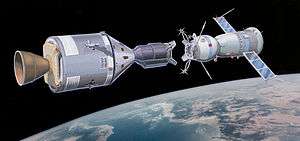1975 in spaceflight
|
Artist's impression of the ASTP docking | |
| Orbital launches | |
|---|---|
| First | 10 January |
| Last | 27 December |
| Total | 132 |
| Catalogued | 125 |
| National firsts | |
| Satellite |
|
| Rockets | |
| Maiden flights |
Atlas SLV-3D Centaur-D1AR Delta 3000 Diamant-BP4 Long March 2C N-I Scout F-1 Titan III(34)B |
| Retirements |
Atlas SLV-3D Centaur-D1A Delta 1000 Diamant-BP4 Saturn IB Scout F-1 |
| Manned flights | |
| Orbital | 4 |
| Suborbital | 1 |
| Total travellers | 9 |
In 1975 several notable events happened in spaceflight such as the launch to Mars of the Viking orbiter/landers missions, the joint Apollo–Soyuz Test Project, and the Venera 9 Venus mission.
- Viking 1 was launched on 20 August 1975 and Viking 2 was launched 9 September 1975. This orbiter/lander mission was to photograph Mars in detail and to find water and life on the surface.
- The Apollo-Soyuz saw an end to the space race with the USA and USSR. The mission was launched between 15 July 1975 and 17 July 1975.
- The Venera 9 mission was launched 8 June 1975 was another successful orbiter/lander mission.
Launches
| Date and time (UTC) | Rocket | Launch site | LSP | |||
|---|---|---|---|---|---|---|
| Payload | Operator | Orbit | Function | Decay (UTC) | Outcome | |
| Remarks | ||||||
| 10 January 21:43:37 |
||||||
| Low Earth (Salyut 4) | Salyut expedition | 19 February 11:03 | Successful | |||
| Manned flight with two cosmonauts, first mission to Salyut 4 | ||||||
| 5 April 11:04:54 |
||||||
| Intended: Low Earth (Salyut 4) | Salyut expedition | 11:26 | Launch failure | |||
| Manned flight with two cosmonauts, first and second core stages failed to separate, flight aborted and crew returned on suborbital trajectory | ||||||
| 9 April 23:58:02 |
||||||
| NASA | Low Earth | Geodesy | In orbit | Successful | ||
| 19 April | ||||||
| ISRO | Low Earth | X-ray astronomy, aeronomics, and solar physics studies | 11 February 1992 | Launch success, payload partial failure | ||
| First Indian satellite; payload failed 4-5 days after launch | ||||||
| 24 May 14:58:10 |
||||||
| Low Earth (Salyut 4) | Salyut expedition | 26 July 14:18 | Successful | |||
| Manned flight with two cosmonauts, final mission to Salyut 4 | ||||||
| 15 July 14:58:10 |
||||||
| Low Earth (Apollo) | International docking | 21 July 10:50 | Successful | |||
| Manned flight with two cosmonauts, Soviet contribution to the Apollo Soyuz Test Project | ||||||
| 15 July 19:50:01 |
||||||
| NASA | Low Earth (Soyuz 19) | International docking | 24 July 21:18 | Successful | ||
| NASA | Low Earth (Apollo) | Docking adaptor | 2 August | Successful | ||
| Manned flight with three astronauts, American contribution to the Apollo Soyuz Test Project, final flight of the Apollo programme and the Saturn rocket | ||||||
| 20 August 21:22:00 |
||||||
| NASA | Areocentric | Mars orbiter | In orbit | Successful | ||
| NASA | Areocentric | Mars lander | 20 July 1976 11:53:06 | Successful | ||
| Lander landed in Chryse Planitia, becoming the first US spacecraft to land on Mars. It operated until 11 November 1982 when communications were lost due to an erroneous command being sent to the spacecraft. Orbiter was deactivated on 17 August 1980. | ||||||
| 9 September 18:39:00 |
||||||
| NASA | Areocentric | Mars orbiter | In orbit | Successful | ||
| NASA | Areocentric | Mars lander | 3 September 1976 22:58:20 | Successful | ||
| Lander landed in Utopia Planitia and operated until its batteries failed on 11 April 1980. Orbiter was deactivated on 25 July 1978. | ||||||
Deep space rendezvous
| Date | Spacecraft | Event | Remarks |
|---|---|---|---|
| 16 March | Mariner 10 | 3rd flyby of Mercury | Closest approach: 327 kilometres (203 mi) |
| 20 October | Venera 9 | Cytherocentric orbit insertion | First orbiter of Venus |
| 22 October | Venera 9 lander | Venerian landing | Landed at 05:13 UTC; ; first images from Venus surface |
| 23 October | Venera 10 | Cytherocentric orbit insertion | |
| 25 October | Venera 10 lander | Venerian landing | Landed at 05:17 UTC |
References
|
Generic references:
|
Footnotes
| Timeline of spaceflight | ||||||||||
|---|---|---|---|---|---|---|---|---|---|---|
| 1940s | 1944 | 1945 | 1946 | 1947 | 1948 | 1949 | ||||
| 1950s | 1950 | 1951 | 1952 | 1953 | 1954 | 1955 | 1956 | 1957 | 1958 | 1959 |
| 1960s | 1960 | 1961 | 1962 | 1963 | 1964 | 1965 | 1966 | 1967 | 1968 | 1969 |
| 1970s | 1970 | 1971 | 1972 | 1973 | 1974 | 1975 | 1976 | 1977 | 1978 | 1979 |
| 1980s | 1980 | 1981 | 1982 | 1983 | 1984 | 1985 | 1986 | 1987 | 1988 | 1989 |
| 1990s | 1990 | 1991 | 1992 | 1993 | 1994 | 1995 | 1996 | 1997 | 1998 | 1999 |
| 2000s | 2000 | 2001 | 2002 | 2003 | 2004 | 2005 | 2006 | 2007 | 2008 | 2009 |
| 2010s | 2010 | 2011 | 2012 | 2013 | 2014 | 2015 | 2016 | 2017 | 2018 | 2019 |
This article is issued from Wikipedia - version of the 11/22/2016. The text is available under the Creative Commons Attribution/Share Alike but additional terms may apply for the media files.
